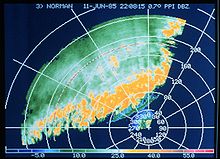
Back Banda de lluvia Spanish نوار باران Persian Bande de précipitations French Faixa de precipitação Portuguese Rainband SIMPLE 雨带 Chinese

A rainband is a cloud and precipitation structure associated with an area of rainfall which is significantly elongated. Rainbands in tropical cyclones can be either stratiform or convective and are curved in shape. They consist of showers and thunderstorms, and along with the eyewall and the eye, they make up a tropical cyclone. The extent of rainbands around a tropical cyclone can help determine the cyclone's intensity.
Rainbands spawned near and ahead of cold fronts can be squall lines which are able to produce tornadoes. Rainbands associated with cold fronts can be warped by mountain barriers perpendicular to the front's orientation due to the formation of a low-level barrier jet. Bands of thunderstorms can form with sea breeze and land breeze boundaries, if enough moisture is present. If sea breeze rainbands become active enough just ahead of a cold front, they can mask the location of the cold front itself. Banding within the comma head precipitation pattern of an extratropical cyclone can yield significant amounts of rain or snow. Behind extratropical cyclones, rainbands can form downwind of relative warm bodies of water such as the Great Lakes. If the atmosphere is cold enough, these rainbands can yield heavy snow.